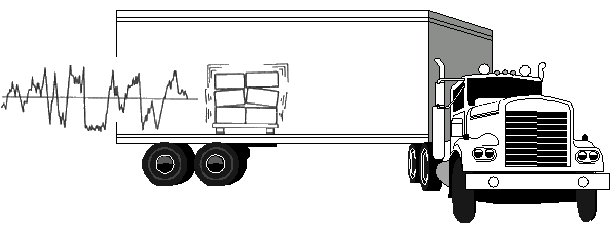Pkg Solutions
Quality Glossary
Vibrational Forces in Packaging
Vibration is the movement of an object in regard to
a static reference position. The distance the pack moves is the amplitude
of the vibration and the time taken for the movement is its frequency.
All methods of transportation have their own frequency
and amplitude of vibration. Most of these, that we will encounter in packaging
are in the 30 to 100 hertz range.
Vibration can come from many different sources, such
as the load and the suspension system of a vehicle and the vibration is
increased by any lumps and bumps in the road or railway track the vehicle
is on. Even things such as uneven tire pressures can increase vibration
in the load by reducing the uniformity of the ride. An uneven load or
poorly stacked unitizer will also contribute to a vibration problem.
When a pack is vibrating it is under acceleration and
deceleration, so this means that "G" level (Please see Drops and Shock Forces in Packaging) is an element to be taken into account and will naturally
be greater in relation to the larger amplitudes of movement that the pack
encounters.

Problems Encountered due to Vibration
Vibration can have numerous effects on a pack and its
product from the minor to the fatal. Some of these are:
Flexing
and cracking in sensitive circuit boards.
Causing
unitized loads to move and due to the added stresses induced, finally
collapse.
Scuffing
of labels and other printed items (this can be reduced by designing the
bottled to have a recess for the label and varnishing and / or reformulating
ink mixtures.)
A shifting
or settling of granular products of cushioning / filling materials.
The three conditions for vibration that can occur in
a sprung load are:
| Direct coupling |
(output = input) |
| Resonance |
(output > input) |
| Isolation |
(output < input) |
Resonance
Resonance is where the vibration felt by a pack and
/ or its product are amplified. All sprung loads, as encountered in, for
instance, a unitized group of packs on a truck, have a unique frequency
to which they will resonate, so resonance occurs when the vibration frequency
is the same as the natural frequency of the pack / product. It is good
practise to check a product and pack for resonance frequencies in the
previously mentioned 30 to 100 hertz range. All three axis should be checked
and all resonance points found and noted. Please see BS EN 28318 for further
details.
A good dampening material will have a natural resonance
of less than half that of the product it is required to protect. Such
materials are usually similar to cushioning materials, but it should be
remembered that ALL materials have a natural resonance
and so a poor choice of cushioning material may lead to an worsening of
vibration damage. For high cost and sensitive products it is sometimes
necessary to use special dampening suspension systems within the pack.
A phenomenon that is particularly destructive is when
a whole load goes into resonance. This induces a "feed back loop",
where all of the packs in the load start to move. The consequence can
be server damage to both the packs and the products they protect. This
is why careful checks for vibration and resonance, plus a general general
gathering of empirical data during transportation tests is vital.